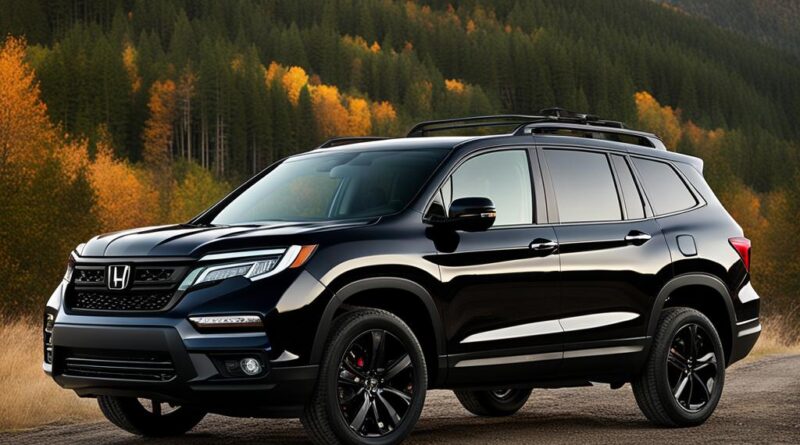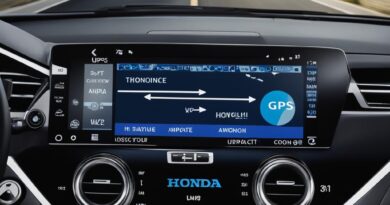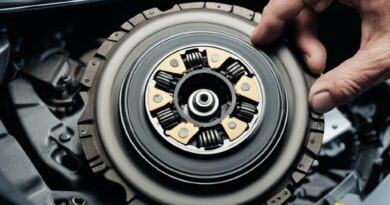Honda Passport vs Pilot: SUV Breakdown & Comparison
In this comprehensive SUV comparison, we will analyze and compare the Honda Passport and Honda Pilot. These two SUVs from Honda are popular choices for families and individuals with active lifestyles. We will break down their exterior features, performance and fuel economy, interior features and space, infotainment and safety features, and provide a verdict on which one is the better choice for you.
Key Takeaways:
- When comparing Honda Passport and Honda Pilot, consider your specific needs and preferences.
- The Passport offers a sportier and rugged exterior design, while the Pilot provides more seating capacity and cargo space.
- Both SUVs have similar performance and fuel economy.
- The Passport has a more compact size, making it ideal for smaller families.
- The Pilot accommodates more passengers and offers a larger cargo space.
- Both SUVs come with advanced infotainment and safety features.
- Test drive both models and evaluate your individual requirements before making a final decision.
Exterior Features
Both the Honda Passport and Honda Pilot have a bold and adventurous exterior design. These SUVs are designed to make a statement on the road and turn heads wherever you go. While they share some similar features, such as roof rails, LED brake lights, fog lights, and headlights, there are subtle differences that set them apart.
The Honda Passport has a more sloped rear window, giving it a sportier and more aerodynamic look. Its muscular lines and rugged appeal make it a perfect companion for outdoor adventures. Additionally, the Passport comes standard with LED fog lights, providing enhanced visibility in challenging weather conditions. On the other hand, the base trim of the Honda Pilot does not include LED fog lights, but it shares the same stylish design and attention to detail with its sibling.
Both the Honda Passport and Honda Pilot have a distinctive presence on the road. The Passport’s sloped rear window and LED fog lights give it a more rugged and sporty appearance, while the Pilot exudes sophistication with its sleek design.
Performance and Fuel Economy
When it comes to performance and fuel economy, both the Honda Passport and Honda Pilot deliver impressive results. Let’s take a closer look at their specifications:
| Specification | Honda Passport | Honda Pilot |
|---|---|---|
| Engine | 3.5L i-VTEC V6 w/ idle-stop | 3.5L i-VTEC V6 w/ idle-stop |
| Horsepower | 280 | 280 |
| Torque (lb.-ft) | 262 | 262 |
| Acceleration (0-60 mph) | 6.2 seconds | 6.2 seconds |
| Braking Distance (60-0 mph) | N/A | Shorter than Passport |
| Towing Capacity | 3,500 lbs. (FWD) 5,000 lbs. (AWD) |
3,500 lbs. (FWD) 5,000 lbs. (AWD) |
| Fuel Economy | MPG: City – 20, Highway – 25 | MPG: City – 21, Highway – 27 |
The Honda Passport and Honda Pilot are equipped with the same 3.5L i-VTEC V6 w/ idle-stop engine, resulting in identical horsepower and torque ratings. Both SUVs offer excellent acceleration, going from 0 to 60 mph in just 6.2 seconds. However, the Pilot has a shorter braking distance from 60 mph, providing enhanced safety measures.
When it comes to towing capacity, both the Passport and Pilot offer the same capabilities, making them suitable for hauling trailers, boats, or other recreational equipment. With a towing capacity of 3,500 lbs. for front-wheel drive and 5,000 lbs. for all-wheel drive, both SUVs can handle your towing needs with ease.
While the performance features of the Passport and Pilot are similar, the Pilot slightly edges out the Passport in terms of fuel economy. With better mpg ratings of 21 city and 27 highway, compared to the Passport’s 20 city and 25 highway mpg, the Pilot offers savings at the pump without compromising on performance.
Overall, both the Honda Passport and Honda Pilot provide powerful performance and competitive fuel efficiency. Whether you choose the Passport or the Pilot, you can expect a smooth and exhilarating driving experience on the road.

Interior Features and Space
The Honda Passport and Honda Pilot prioritize family comfort and flexibility with their impressive interior features. Both SUVs offer a range of amenities that enhance the overall driving experience.
“The interior design of the Honda Passport and Honda Pilot reflects their commitment to providing a comfortable and luxurious environment for both the driver and passengers.”
Some of the shared interior features in both the Passport and Pilot include:
- Leather-trimmed seats for a sophisticated touch
- Tri-zone automatic climate control to ensure everyone’s comfort
- Heated leather steering wheel for a cozy grip
However, the biggest difference between the two models lies in their seating capacity and cargo space:
| Honda Passport | Honda Pilot | |
|---|---|---|
| Seating Capacity | 5 passengers | Up to 8 passengers |
| Cargo Space | Impressive volume behind the second row | Cavernous cargo space |
Image courtesy of Honda
The Honda Pilot’s larger size allows it to comfortably accommodate up to eight passengers, making it an ideal choice for larger families or those who frequently travel with a group. Additionally, the Pilot’s ample cargo space ensures that you’ll have plenty of room for all your gear and belongings.
On the other hand, the Honda Passport’s five-passenger seating capacity offers a more intimate setting, perfect for smaller families or individuals who prioritize a roomy cabin. While it may not have as much seating capacity as the Pilot, the Passport still provides ample cargo volume behind the second row to accommodate all your essentials.
Verdict:
Both the Honda Passport and Honda Pilot excel in providing a comfortable and well-equipped interior. Choosing between the two ultimately depends on your specific needs and preferences. If you require more seating capacity and cargo space, the Honda Pilot is the better option. However, if you prefer a more compact SUV with ample cargo room and a smaller seating capacity, the Honda Passport is the perfect fit.
Infotainment and Safety Features
The Honda Passport and Honda Pilot are equipped with advanced infotainment systems that enhance your driving experience. While both SUVs offer impressive features, there are some notable differences that set them apart.
Infotainment Features
When it comes to infotainment, the Honda Passport and Honda Pilot have their unique advantages. The Pilot boasts a larger touchscreen display, providing you with a more immersive interface for controlling various features. Additionally, the Pilot offers a multi-zone audio system, allowing different audio sources to be played simultaneously in different parts of the vehicle. This is especially convenient if passengers have different music preferences.
On the other hand, the Honda Passport takes the lead with standard Apple CarPlay and Android Auto integration across all models. These features allow you to seamlessly connect your smartphone to the vehicle’s infotainment system, providing access to your favorite apps, contacts, and navigation. Furthermore, the Passport comes with an 8.0-inch touchscreen infotainment system, providing user-friendly controls and easy visibility.
Safety Features
Both the Honda Passport and Honda Pilot prioritize safety, offering a range of advanced features to keep you and your passengers protected on the road. Both models come equipped with Honda Sensing® Safety & Driver-Assistive Technology, which includes Collision Mitigation Braking System, Adaptive Cruise Control, and Lane Keep Assist. These systems work together to help prevent collisions and maintain a safe driving environment.
Furthermore, the Pilot features an advanced rear entertainment system, providing entertainment for rear-seat passengers on long journeys. This entertainment system includes a rear-seat entertainment screen, DVD player, and wireless headphones. It’s a great feature for keeping passengers entertained and occupied during road trips.
Ultimately, both the Honda Passport and Honda Pilot offer impressive infotainment and safety features. Whether you prioritize a larger touchscreen display and multi-zone audio system (Pilot) or standard smartphone integration and user-friendly controls (Passport), these SUVs have you covered. Additionally, the advanced safety technologies in both models provide peace of mind during your daily commutes or family adventures.

Conclusion
When it comes to choosing between the Honda Passport and Honda Pilot, it ultimately boils down to your specific needs and preferences. The two SUVs have distinct characteristics that cater to different lifestyles.
The Honda Passport stands out with its sporty and rugged exterior design, making it an ideal choice for those seeking a more adventurous and versatile SUV. With its sleek lines and aggressive stance, the Passport exudes a sense of excitement and readiness for any journey.
On the other hand, the Honda Pilot offers an abundance of seating capacity and cargo space, making it the perfect choice for larger families or those who frequently travel with a large group. The Pilot’s spacious interior ensures that everyone can ride comfortably, while its generous cargo capacity allows for ample storage for all your belongings.
Both the Honda Passport and Pilot offer similar performance and fuel economy, as well as a wide array of interior features and advanced safety technologies. Whether you prioritize a sportier look or require the extra seating flexibility, both models deliver exceptional value and reliability that Honda is renowned for.
To make an informed decision, it is crucial to test drive both the Passport and Pilot and consider your individual requirements. Be sure to assess factors such as the number of passengers you often carry, the amount of cargo space you need, and your desired aesthetic. By carefully evaluating these factors, you can confidently determine which SUV aligns with your needs and enhances your driving experience.
FAQ
What are the differences between the Honda Passport and Honda Pilot?
The Honda Passport and Honda Pilot have slight differences in their exterior design, with the Passport having a sportier look. The Pilot can accommodate up to eight passengers, while the Passport comfortably seats five. The Pilot offers a larger cargo space and more legroom, while the Passport has foldable third-row seats in the Pilot for additional cargo space.
What are the exterior features of the Honda Passport and Honda Pilot?
Both SUVs come with roof rails, LED brake lights, fog lights, and headlights. They also have a moonroof with a tilt feature. The Passport has a more sloped rear window and a sportier look. It also comes standard with LED fog lights, which are not available in the base Pilot trim.
What is the performance and fuel economy of the Honda Passport and Honda Pilot?
Both SUVs are equipped with a powerful 3.5L i-VTEC V6 w/ idle-stop engine, delivering 280 horsepower and 262 lb.-ft of torque. They offer good acceleration speed, reaching 0-60 mph in 6.2 seconds. The Pilot has a shorter stopping distance from 60 mph. In terms of towing capacity, both SUVs can tow up to 3,500 lbs. (FWD) and 5,000 lbs. (AWD). The Pilot has slightly better fuel economy compared to the Passport.
What are the interior features and space of the Honda Passport and Honda Pilot?
Both SUVs come with amenities like leather-trimmed seats, tri-zone automatic climate control, and a heated leather steering wheel. The Pilot can accommodate up to eight passengers, while the Passport comfortably seats five. The Pilot offers a larger cargo space and more legroom, making it ideal for larger families. The Passport has ample cargo volume behind the second row and has foldable third-row seats in the Pilot for additional cargo space.
What are the infotainment and safety features of the Honda Passport and Honda Pilot?
Both SUVs come equipped with advanced infotainment systems. The Pilot offers a larger touchscreen display, a multi-zone audio system, and an advanced rear entertainment system. The Passport has standard Apple CarPlay and Android Auto integration across all models, as well as an 8.0-inch touchscreen infotainment system. In terms of safety, both SUVs come with Honda Sensing® Safety & Driver-Assistive Technology, including Collision Mitigation Braking System, Adaptive Cruise Control, and Lane Keep Assist.




